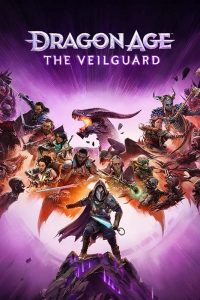 Dragon Age: The Veilguard
Dragon Age: The Veilguard
BioWare is one of, if not, EA’s most celebrated studios. They were the original creators of the Baldur’s Gate franchise and Star Wars: Knights of the Old Republic, though they are mostly known nowadays for creating the highly renowned Mass Effect series. Amongst their beloved franchises is Dragon Age, a grimdark fantasy series about a demonic force called the Darkspawn and the blight that comes with them attacking and corrupting the land of Thedas. The series has been praised by many, with its third game Dragon Age: Inquisition even winning game of the year at the first ever Game Awards. Now, after nearly a decade since the last entry, we have the release of Dragon Age: The Veilguard, the fourth game in the series – originally called Dragon Age: Dreadwolf before having its name changed in 2024. This game was released on 31st October 2024 for PlayStation 5, Xbox Series X/S and Windows.
Story
The game takes place ten years after the events of Dragon Age: Inquisition. You take on the role of Rook, a mercenary recruited by two dwarfs, Varric and Harding, to stop the elf god Solas from tearing down the Veil and flooding the world with demons. They encounter Solas performing the ritual needed to bring down the veil and our gang manage to put a stop to it. Though doing so leads to disaster, as it inadvertently releases the elven gods Elgar’nan and Ghilan’nain, who plan on harnessing the power of the blight and the darkspawn to build a new empire atop of what remains of Thedas. This encounter also traps Solas in the fade and badly injures Varric. Now, with these gods released, it’s up to Rook and his friends to form a team, with Solas aiding our hero from within the Fade, and convince the many factions of Thedas to unite and defeat this new threat, before calamity befalls upon their world.
I’m not really a massive fan of this story. For the most part it’s fine, but a lot of it is really forgettable in my opinion. One definite issue with the story is the tone. As I said, the series is a grimdark fantasy where the apocalypse is at the world’s doorstep. And while there are definitely dark events and plot points spread through the story, the game’s tone doesn’t really match that, at the very least not as well as previous games did. Dialogue is a very heavy indicator of this. Thankfully they haven’t tried to mimic the quippiness of a Marvel movie, and they have the characters take the situation seriously, unlike games like Forspoken and Immortals of Aveum, but it still doesn’t quite match the tone that the game’s trying to establish, being quite light-hearted and not really reacting to what is essentially the worlds potential end.
One big part of BioWare’s story-focused games are the choices you make affecting multiple parts of the narrative. For starters, usually, things like what race you pick or the faction you were a part of will often lead to people treating you differently or will give you a unique prologue depending on which race or class you picked. The main difference you really get in this game is who recognises you when you meet them as well as new dialogue options, nothing really that substantial. Speaking of dialogue choices, these also affect certain aspects in the story in BioWare games, from character relationships to even who will survive at the end of the game. This isn’t nearly as deep this time around, as it really doesn’t feel like your choices matter in the grand scheme of things. Yes, some of your choices do lead to different outcomes, but there are never any significant consequences for your choices, and the results of said choices will often be shown via side quests. It feels like they’re trying to mimic their old success but are afraid to go as far as they did previously, making this game feel really shallow by comparison.
Presentation
Graphically, the game looks pretty good. The areas you visit are really pretty, each being distinct from one another, not just with layout and location but even with the colour schemes – show me a screenshot and I’ll be able to tell you where that place is just by colour alone (just so long as I don’t have to tell you the name of it… I’m terrible with names).
Character models on the other hand, I’m quite mixed on. I can’t deny they do look good, just like the environments, they are well detailed and look incredibly clean, but they don’t feel like they belong in a Dragon Age game. Characters look a bit too cartoony; I’ve heard someone say they almost look like Pixar characters, and while I wouldn’t go that far, they are yet another aspect that conflicts with the tone and the setting of the game. They do look good, don’t get me wrong, but they feel like they belong to a different game, especially when compared to previous entries.
Honestly, the most I can say for voice acting is that it’s fine. While actors are far from emotionless, they definitely aren’t brimming with it either. Your companions are definitely the best acted, feeling the most distinct of all the characters and are the most enjoyable to interact with, with Jee Young Han as Bellara being my favourite. Unfortunately, I think one of the blander performances come from Rook themself, it almost feels like every piece of dialogue is said in the same way with the same mannerisms. I wouldn’t say it’s a bland performance at all, but there’s also not a lot of range in their voice. Though aside from those, a lot of the performances are fairly unmemorable, nothing groundbreaking but also nothing appalling, just fairly average.
The soundtrack, once again, is just fine. Some of the songs do match the settings, feeling like something you could listen to while reading battle scenes in Lord of the Rings, while others don’t really, sounding like they would be more in place with a superhero movie. Just like with a lot of this game, these songs really don’t feel like they fit the grimdark setting – I know I keep bringing it up, but I think it’s worth signalling when you have a series with a known setting and tone deviating from said setting and tone. Honestly, it’s pretty forgettable.
Combat
(I played as a warrior in this playthrough, so your experience with combat may vary from mine)
Dragon Age: The Veilguard has pretty bog-standard combat. It’s an action RPG that utilises close and ranged combat, the skill you have with both being dependent on your class. For example, the Warrior can take more abuse but is severely lacking in ranged abilities, while the Rogue isn’t as good defensively but is a lot more nimble.
You go into battle alongside two other allies that you get to pick before entering the location you’re teleporting to or is predetermined for certain story and side quests. Unlike you these allies don’t have any health, so you won’t have to be worrying about them during a fight. They will often fight on their own accord and will target the nearest enemy if you leave them alone, though you can give them directions and tell them which monsters to fight. Your allies are actually really useful, they do draw enemies away from you, so you won’t be bombarded by attacks and they deal fairly good damage, they actually managed to defeat a decent number of enemies, which is more than I can say for some games.
Melee combat is really simple. You don’t have any unique combos, just a single button attack chain, meaning that you’re going to be doing a lot of button mashing. There is a second attack chain you can pull off, but it’s better used for enemies with shields than for normal combat, and honestly, I used it so little I keep forgetting that it was even a thing. The type of weapon you use for ranged attacks will depend heavily on what class you pick, in my case, Rook decided to pretend to be Captain America and throw his shield at enemies on higher platforms, though there are of course other types of weapons like bows and staffs. I’m not sure if it’s just the type of weapon that I used, but I found myself only really using ranged attacks against enemies I was running towards instead of using them to outright kill them. Maybe it was because I had to wait a couple of seconds before I could throw my shield again, maybe it was because it didn’t deal that much damage, but, while not useless, it was never really the coup de grace of my arsenal.
You and your allies of course have a series of skills you can utilise in battle. Your allies have a few predetermined abilities while you have a large number that can be unlocked via a skill tree. There is no mana in this game, though skills do have to be charged up by you hitting enemies, meanwhile your companions will have to suffer a hefty cooldown before they can use a skill again. As usual, there are a few support skills, ones that will heal you or will give you a slight buff for example, though most are of course attacks. None of these attacks are especially powerful, the main purpose of a number of them being to inflict status ailments, and there are some really cool effects, like overwhelmed dealing extra stagger damage, siphoned draining opponents of their health and healing the caster, there’s even an ailment simple called Bees! I’m not joking. That being said, there is one part of these skills that I really like, some skills are labelled as primers, meaning that they’ll inflict one of two status ailments to an opponent, and there are some labelled as detonators, that when cast on an enemy inflicted with the corresponding ailment will cause an explosion not only dealing damage to the enemy but will also hit monsters surrounding it. This mechanic is easily my favourite part of combat, it makes me think of which allies I want to bring with me, as well as what spells I should use. It’s a unique feature that makes the fights more enjoyable.
Surprisingly, combat in this game never really got boring. Yes, it does get a bit monotonous in longer playthroughs, but it’s surprisingly enjoyable for how simple it is. That being said though, there is one main criticism that does make the fights tedious. You may have seen online that a lot of players suggest playing the game on easy mode, this isn’t because of difficulty – in fact this game isn’t really that hard – but because it means that fights don’t go on for nearly as long. Why is this? Enemy health bars are ridiculous in size. It’s a similar problem to what I had in Lies of P where some opponents had way too large health bars, though while in that game there are workarounds and ways to make them less arduous, you really don’t in this game. This leads encounters to go on for way longer than they have any right to, making them feel sluggish and like you’re making barely any progress. And what makes it worse is the EXP you receive at the end of the fights. In these fights, it doesn’t matter how many enemies show up, or how long it takes to kill them, the amount of EXP you gain is predetermined every time, and what you get is pitiful. Even against the mini-bosses I randomly stumbled upon, which could take me upwards of fifteen to twenty minutes to kill just because of how unnecessarily large their health is, and I’ll still get the same amount I would receive from a thirty second tussle with a few Darkspawn. It discouraged me from fighting all together, no matter how fun they could have been, making me want to run away from the fight because I knew how little it was worth it.
Side Quests
First of all, I have to comment on how many side quests there are. You want to know why this game took me this long to finish and review (aside from Metaphor Refantazio taking up the vast majority of two months), it’s because so much of my time was spent on completing side quests and these were not short ones either, sometimes taking me ages to complete. And even then, I don’t think I managed to complete half of what the game presented to me.
Some of these can just be found while wandering the town or forest or wherever you are, whether it’s someone begging for your aid, or possibly just found as a document on the wall. Some of these will be given to you by the local faction, requesting your cooperation and helping you get closer to them. Side quests are really where you get all of your EXP, as you get a large portion almost every time you complete one. I found myself levelling up after doing only a couple of the things.
One mainstay in BioWare RPGs are the companion sub quests. Of course, your allies will have their own strife’s that they have to deal with and you’re there to help out no matter what it is, getting you closer to your allies and possibly even starting a romance with one of them. These are my favourite side quests in the game, to the point where I made sure I completed them all before starting any of the endgame missions – especially as completing them determines whether or not they survive these missions. All the side quests are interesting and help establish more with your allies, like helping Harding get a handle of her new magic powers, or Davric in saving the last remaining griffons, or even Taash discovering and coming to terms with being non-binary. These quests are definitely the best in the game and got me to like the companions I was saving the world with.
Customisability
I don’t talk about Skill Trees very often anymore because of how samey and almost pointless they feel, just being a line of abilities you have to slowly unlock. This time however, I feel like this is one that really needs to be talked about. For starters, it’s literally impossible to unlock everything in a single playthrough, not only do you only get skill points once you level up, but some skills will also be permanently locked off because you decided to go with a different one. Another thing I really like are the builds you can use. Once you reach a certain level you are able to unlock build specific abilities that you’ll be locked into as the game continues. These builds work very differently, not only in the skills you can unlock but also the weapons best used for them. For example, with the warrior, you have the Reaper build, which has attacks that can inflict the siphon ability, or the champion specialising in shield usage. If you don’t like one build or have second thoughts on how your character is progressing, you can of course reset everything and allocate your skill points to different abilities. In my opinion, this is how a skill tree should be done, giving you options and letting you customise how your character plays instead of just having skills and stat increases that you have to progressively unlock.
One last thing I feel is really worth mentioning is armour customisability. Say you have a piece of armour that has really good stats, but you either don’t like the looks of it or it doesn’t go with the rest of your set. On the other hand, you could have an item of clothing that you really like the look of but has terrible stats. Well, you’ll be as happy as I am when I tell you that you can have both fancy looking equipment and equip the useful stuff at the same time. When in your base you can customise how your equipment looks, having what you’re wearing take the form of a different armour set or weapon that you currently own. You can even buy equipment appearances from merchant stalls, whose sole purpose is to change the appearance of whatever you’re carrying. This is yet another thing that I really like. Customisability and making sure my character looks as good as they can is really important to me, so the ability to personalise my protagonist without having to sacrifice stats for it is something I will forever praise.
Conclusion
The review scores for this game are all over the place. Some reviewers absolutely love it, saying it’s one of 2024’s best games, while others say it’s one of the most shallow Dragon Age games to date and is terrible. I wouldn’t go as far as either of these do, but I do have to agree with their points. This game is fun, with solid combat and interesting characters, but there are also a number of things that do make it severely lacking compared to other BioWare games, on top of all the other flaws it has. I do think that this game is worth the price, and I do recommend it for anyone who’s interested, though if you’re wanting to get into the Dragon Age series, I’d probably suggest trying out one of the other games. It’s a good game, great at times, but it can definitely do better.
7.5/10
Anime Amigo and Nerd Consultant
Share This Post:







Leave a Reply